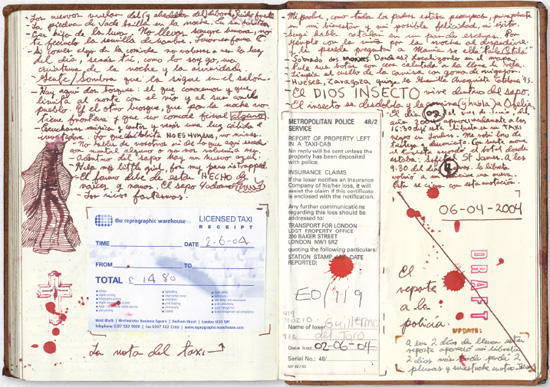
Notebook 3, Pages 48A and 48B, which include the receipt for the taxi ride in London during which del Toro lost his notebook [left], as well as the record of the police report del Toro filed [right].
Most of all, Guillermo’s notebooks present the same creative generosity one finds in the man himself. Whether he’s talking in the room where it always rains, or adding to his notebooks, or sharing his fantastic visions on-screen, he gives the gift of his whole self, and in this way makes our world a little more messy, visceral, boisterous, and exalted.
The thing about great storytellers is that they are full of great stories. Pretty much everything Guillermo says or writes is by turns fascinating, surprising, appalling, hilarious, enchanting, or moving. And like all truly great storytellers, he’s also a great soul. His stories can’t help but instruct, impart, and illuminate. In Hollywood, a dark vision is often merely a faddish pose. But you can tell when a writer-director has never seen a dead body, never spied anguish up close. With Guillermo, his heart of darkness is authentic, born of a fully lived life. He not only observes deeply but feels deeply, and he has survived to tell the tale.
“You try to make the right choices,” Guillermo notes. “I’m not a fatalist. I think that the plan, the universal plan and the universal energies, have a direction for everything. I don’t think there is a design that we can comprehend, but I think that we are all agents of destruction or construction in our lives, and one must try to make the best choices within that. When people talk about heaven and hell, I always think of Defending Your Life, the Albert Brooks movie. I think that you have a responsibility not to propagate the cancer of despair, resentment, and envy. You have the responsibility to make the right choices for the people around you and yourself. We are not going to be important, but I think the collective choices that we make are. We are going to be extinct or not by the accumulation of those choices.”
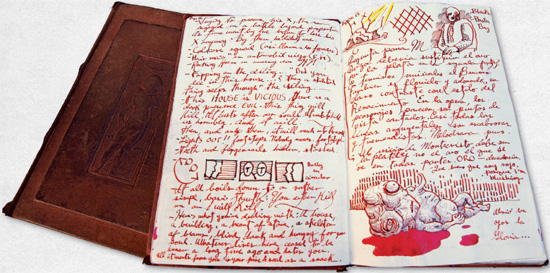
Notebook 3, opened to Pages 9A and 9B while resting on Notebook 4. Since starting his third notebook, del Toro has always used the same type of leather-bound volume, a number of which he bought from a vendor in Venice while traveling to promote Cronos.
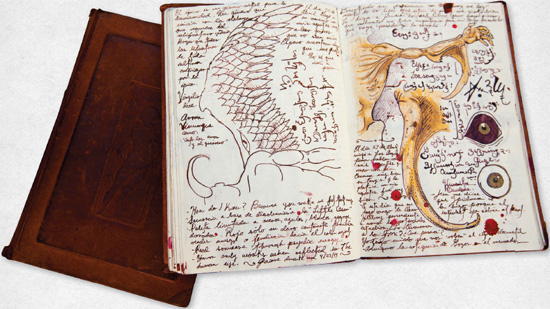
Notebook 3, Pages 17A and 17B.
On one of the notebook pages for Pan’s Labyrinth, Guillermo has the Faun giving Ofelia a volume that reads, “The book contains every possible destiny, every possible future which your decisions could create. It was made just for you, written in your father’s blood, and will reveal its secrets to your eyes alone. Infinite and limited.”
Of this, Guillermo says, “That’s very Borges and is ‘The Garden of Forking Paths.’ Because the whole movie is about choice, and every choice gets defined when it’s made, and the choices are revealed only at that moment. So the Faun gives her a book where essentially the book tries to guide her one way or another, and she takes her own choice. This is the book that writes itself, a riff on a famous Borges story called ‘The Book of Sand,’ where every page you turn fuses with the rest and is both infinite and limited.”
Through the images in this book and the conversations with Guillermo, you’ll be given the opportunity to see the world through different eyes. There is wisdom here and heartache, exaltation, exhaustion, joy, and deep compassion.
When Guillermo began writing in the notebooks, they were for himself, then for his daughters, and now we have been invited to share in them. And at the very last, these notebooks are addressed to the boy Guillermo once was, to his past and future, a love letter of hope and of the impossible made possible. As he puts it, “If I were a kid in Mexico and I read this book, I’d be inspired.”
At this stage of his life and career, Guillermo knows full well that whatever path he chooses, it will be the journey he is meant to be on… the road he has built for himself.
COLLECTIONS
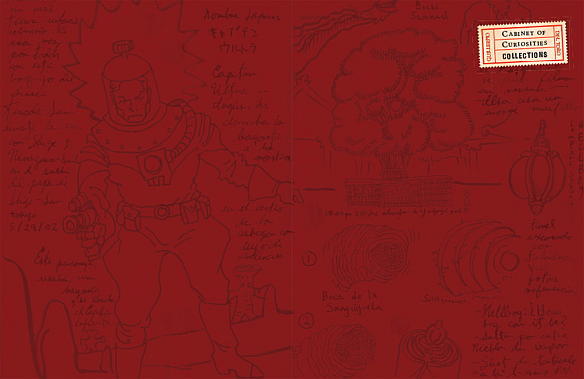
Notebook 4, Pages 43A and 43B.
BLEAK HOUSE
“Anything to vary this detestable monotony.” —CHARLES DICKENS, BLEAK HOUSE
“They’re my friends. I made them.” —J.F. SEBASTIAN, BLADE RUNNER
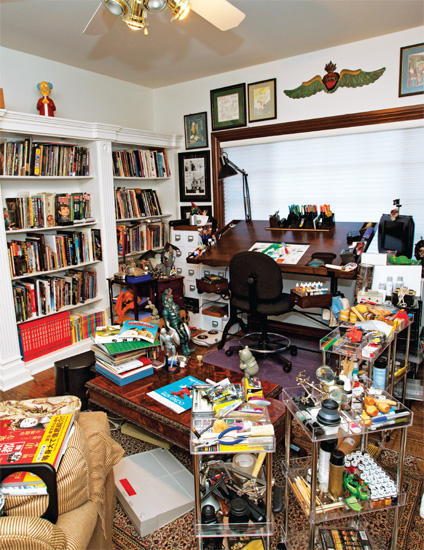
The Comic Book Library at Bleak House.
“TO ME,” GUILLERMO CONFESSES, “the beautiful thing about Bleak House is that when I come in and go out of the house, it is cleansing for me. Catholics go to church, Jews go to temple. I come here.”
He adds, “Spiritually, my life is here. I exist in this house, really.”
Bleak House is Guillermo’s second home and working office, his artistic masterpiece, his cluttered attic, his pride and joy. It’s where he goes to draw and write, to recharge his batteries, to explore unfettered his creative whims. When in Los Angeles and residing at his family’s home nearby, he visits Bleak House at least two hours every morning and one hour at night, seven days a week. He delights in giving tours to luminaries from around the globe, including other noted directors.
The moment you step inside, you are dazzled by the extent of the visual delights. Bleak House bursts with “over 550 pieces of original art,” Guillermo notes. In fact, Bleak House has recently grown, so extensive is the collection. What began as one house has now expanded to include a neighboring structure, which is still finding its own distinct identity. Like the first, it features Guillermo’s prize possessions. For instance, the second wing’s living room is filled with magnificent preproduction maquettes of creatures from Pacific Rim (2013), which are flanked by a stunning bronze by Stanislav Szukalski and a full-size replica of Robert Picardo’s Meg Mucklebones from Ridley Scott’s Legend.
“When I was a kid,” Guillermo says, “I read Vathek by William Beckford. In it, Fonthill Abbey was mentioned. That was his personal treasure: an entire building—or series of Gothic buildings—created to lodge his collection of strange artifacts, oddities, and scientific anomalies. He inherited an obscenely large fortune, so he was able to secure every treasure he could dream of. And dream he did. Within my means, I have also indulged in collecting. But I do it because it is the world as I understand it; as it exists in my soul.”
Guillermo is quick to point out that neither Bleak House is intended to be a museum or storehouse. Both homes are working spaces, with each room serving a different purpose. “For example, I have a room where I assemble models,” he says. “The reason is as banal as the fact that it is well-lit and is set up so I can put the actual place where I assemble the models close to a window. Because I need to ventilate when I prime. Otherwise I get really high.”
However, creative inspiration, not base practicality, is what Bleak House is made for. In the main house, Guillermo says, “The Rain Room is literally my favorite place. I spend 90 percent of my time at Bleak House there, writing. But my second favorite room is the Sun Room, the Manga Room, the cabin in the back. I love to draw there, more than in the real drawing room, which is upstairs, because the Manga Room has really good energy. It’s so peaceful.”